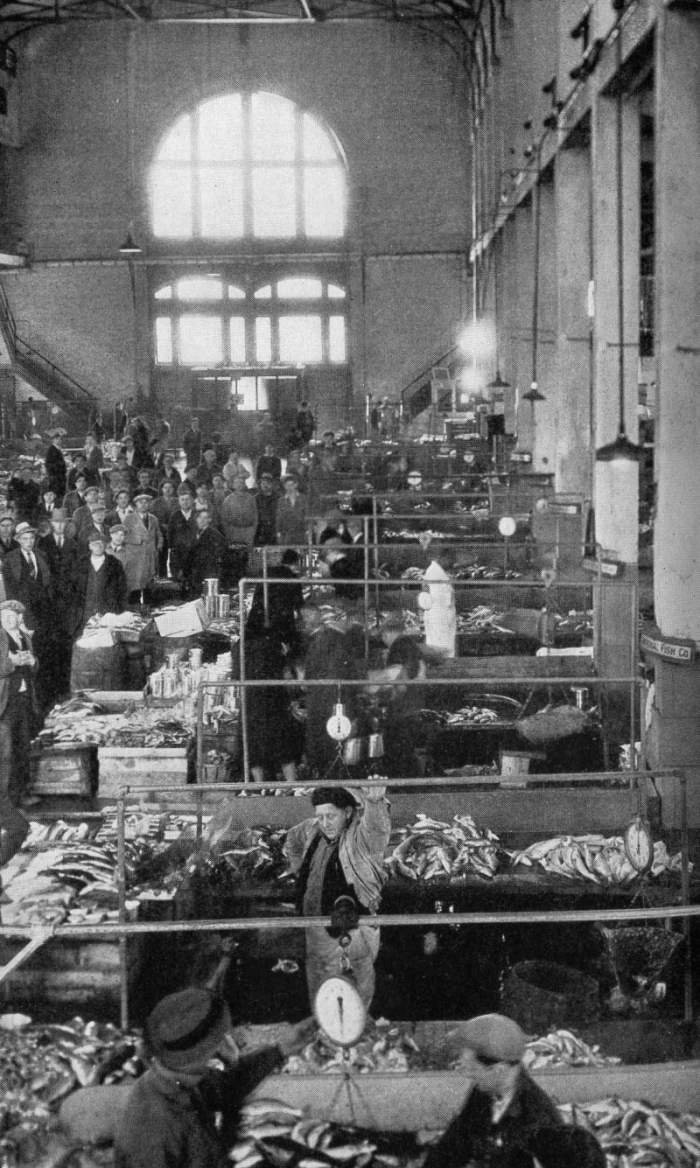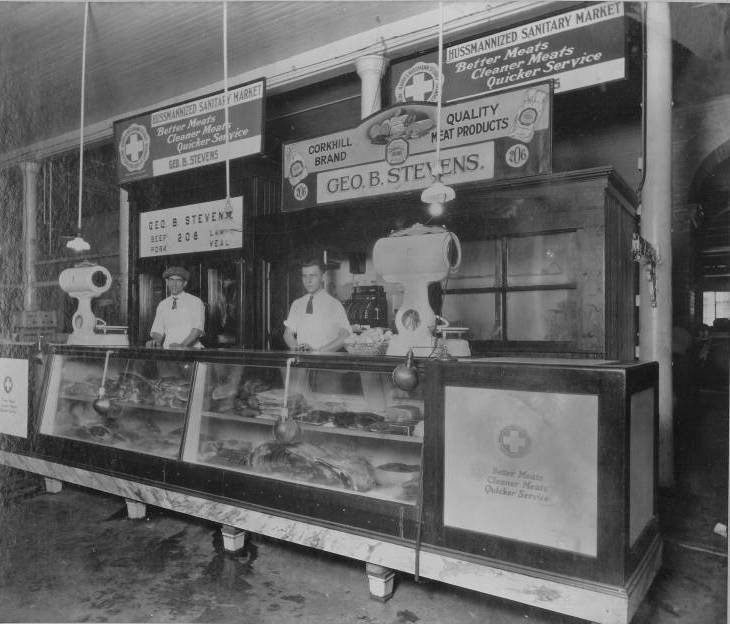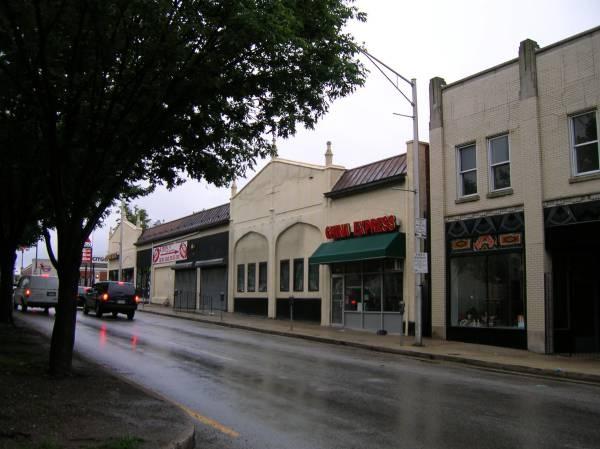


 ...
...|
.The
Fish Market
(
Better Known as ) Centre Market ( in earlier
years - Marsh Market )
17 Market Place
In 1787 ( by some accounts - 1763 by
a lottery ) , three markets were built by
Baltimore, the largest being the Marsh market
( AKA - Centre Market ) . The other two were
the Hanover Market in downtown and the Fell's Point
Market. The
old market had the knickname of the " Old Marsh
Market" for many years, and was one of several
markets in a complex in the block also known as the
Center Market. Back then, the location was known as
Harrison Street, and the market was built on top of a
old marsh, on the banks of the Jones Falls, and
extended for years south towards Pratt Street.
The market burned down in the Great Fire of 1904, but
was rebuilt at a cost of $500,000 to $ 650,000,
depending on which account you believe.
Later known as Baltimore's
Fish Market, it survived
into the early 1980's, when the entire operation was
moved first out Northeast on Route 40, Pulaski Highway
( near the City Impound Yard ) and later to
Jessup Maryland. The building was converted into a
night club , called the Fish Market and is now a
Discovery Zone, an attraction for the kiddies.
.
 ............ ............ .Interior of Baltimore's Fish Market,
Circa 1935.
..
 |
..
|
.
|
. |
|
North Avenue Market
14-34
West North Avenue
.
 ................................................ ................................................ Baltimore's North Avenue
Market, when it first opened, would
deliver to customers all the way in Anne
Arundel County. Stall's were operated by such
names as George B. Stevens, E.T. Wright,
Bien's, Gerber's, Brose, Hoods, Mitchell (
meats ) , Larry K. Hill, and Kasten ( poultry
) , Lafayette and Martin ( seafoood )
and B.W.Fox ( candy ) . just to name a
few. There were even bowling alleys in
the market and just up the street, a block to
the East , was the Sports Centre for ice
skating. The Market, which was a private
market and not a City Operated market, closed
by the 1960's, and also suffered a fire around
that time. The building still stands and has
been converted to retail use. Mentioned in one
listing I found as "Baltimore's Largest
Enclosed Santiary Market"..
|
..
 |
.. |
. |
 |
 |
.  |
..
 Photos
- Courtesy of the Baltimore Gas and Electric Collection at the Baltimore Museum of Industry |
.. .
 |
|
Belair Market
Forrester Street at Orleans Street
.

The Belair Market was built
in the area of Forest , Hillen and
Orleans Street . At that time, the market
was 285 feet long, 65 feet wide, and had
iron columns holding up the roof. In 1871, a
wind storn torn the roof off the building
and later large stones were placed to anchor
the roof. The old market, which had been
rebuilt over the years was torn down
several years ago, and the entire Gay Street
area is currently undergoing change, with
much of it vacant.
|
|
|
..

..Old Postcard view of the Belair Market,
Baltimore.
|
|
Northeast Market
601 North
Chester Street
Just a few
blocks east of Johns Hopkins Hospital, Northeast
Market is still open and appears to be doing well.
.
 .Many thanks to
Ed for the photos.
.
 |
|
Lexington
Market
200 North Eutaw Street
.
 Lexington Market has been
around for years, starting operations in
1782, named for
the Battle of Lexington. Before the
market came to be, the " hilltop " had been a
fairground. When the market opened, it was
more of a outdoor market, but by the early
1800's, rows of sheds were built, and
later a market building was built, on a spot
known as Howard's Hill. The site had been used
before the market for horse races and out door
events, and from what I've read, the crowd
could get pretty rowdy at times. Part of the
market, on the corner of Lexington and Eutaw,
had been a flower market, and around holidays,
mainly Easter, the street would light up with
all the Spring flowers.
The Lexington Market suffered
several fires, and the original building
finally burned down in the 1950's. It
was replaced with the market building that
stands to this day, seen in the last three
pictures. Shopping days were Tuesday, Friday
and Saturday. Much as been written about the
Lexington Market, from the stories of open
market shopping, with pens of chickens and
produce everywhere, where
one writer mentions the lucky turkey walking
about the market just after Thanksgiving in
the 1880's, looking as if it it didn't have a
care in the world. Another writer wrote that
the market smelled like a combination of
everything being sold that day .
By the 1930's, many of
the businesses inside the market wanted the
smaller outside and sometimes illegal stalls
set up outside the market to leave, as they
had affected the business inside. Inside the
old market, there was a larger central aisle,
colored in red, which was more for meat
sellers. Two smaller narrower aisles
could be found on either side, those for
everything else, such as fruits, vegetables,
cheeses, etc. On the West side of the Market,
a Fish Market section was set up, while on the
East side, flower stalls were set up.
.
 .Above,
Lexington Market, circa 1935. Below,
the Market in the 1950's.
.
 Back in
the day, there were certain days that the
markets around Baltimore were open. The best
time to shop was in the early morning, when
things were fresh and there was plenty to shop
from. While the selection might not have been
that good in the later hours, the prices could
often be bargained down a bit better, with
what was left to buy. The stalls each had a
license , which were worth quite a lot, and
by the 1950's, some business owner made
more money allowing other sellers to use
their licensed stalls, sub leasing the stalls
at a profit. Vegatables were often sold in "
Levies ", a " levie " being 12 1/2 cents.
|
. |
 |
|
..
 ........................... ........................... Circa 1905 , the L.H. Hettbrg stand
at Lexington Market ........
|
.
 |
........ |
. ............................................................. .............................................................
|
 |
/ |
.
 |
.. |
|
Richmond
Market
301 West Read
Street @ Howard Street
Richmond Market was built
in 1853 on the site of the old Richmond Market.
In 1874, the building was extended north, under
the Fifth Regiment Armory .
In the late 1870's, the market was located on the
first floor of the building , and the Fifth
Regiment Armory was located on the second story of
the building.
The old market has long been closed and has been
converted into part of the Maryland General
Hospital.
 |
 |
|
..

.
 Early photo of
the George B. Stevens stall at the Richmond Market
in Baltimore. Stevens also had a stall in the
North Avenue Market as well...
...........................................................................................................................Photo
courtesy of Jennifer. .
 . . |
|
Fell's Point Market ( Broadway
Market )
1701
Fleet Street
(Broadway and Eastern Avenue)
The first market
in Fell's Point opened in the area around
1784. By 1864, a brick structure had been
built to house the markets. The older market
building burned down in the 1950's, but was
rebuilt. One the second floor of the market
was a public hall and at one time, a Volunteer
Fire Company met there. Apparently, the land
for the market was donated by Edward Fell.
 .............. ..............
.
 ........ ........ Fell's Point
Market in the 1950's - In later years, the upper
floors were taken down due to fire and costs.
|
|
Hollins
Market
900 Hollins Street
Hollins Street and South
Carrollton Streets
Built 1865 / organized in the
1830's
.

In 1835, the Hollins Market
was erected to serve West Baltimore. A second
floor was added in 1864. and by 1871 , the
market was extended once again. I have heard
that in it's day, the Market extended West all
the way to Carey Street, with the addition of
street stands that opened up over the years.
My Grandfather grew up on Gilmor Street north
of Edmondson Avenue and talked of the walk to
the Hollins Market once a week. The Hollins
Market is still open.
.
 ........................................... ........................................... |
|
Waverly Market
listed as 32nd and
Greenmount
(
More like Greenmount and 33rd -
Southwest Corner )
The Waverly Market building
is currently still in use to this day, but no
longer as a private market. The building is
currently occupied by several small stores.
Listed in a directory from the 1920's as such :
" Baltimore's, as well as the countries
newest and most modern , complete, sanitary
food center. Free Delivery Service, Free
Parking ". There have been signs that
planners are looking at the block for some
development, but so far nothing has happened and
I'm not sure if the old market building would be
incorporated into those pending plans or not.The
Waverly Market was a private Market, as was the
North Avenue Market, and were not considered a
part of the Baltimore City run Market System,
and did not last long as a marketplace.
|
|
..

|
....
 |
.
|
|
.
.. |
 |
UPDATED - 2017
|
|
Still working
on these :
... Canton
Market - Built in 1859 at O'Donnell Street
and Potomac Street ( 3000 O'Donnell Street ) .
In 1876, half the market collapsed after a fire.
....Lafayette Market
- Built in 1869, on a lot known as " Sewell's Lot "
, at Pennsylvania Avenue, Cook Street and Fremont.
Promoted as a
New Marketplace for the Northwest Part of the City.
In 1871, the roof was lifted off in a windstorm, and
in later years the Market suffered from several
fires. The Market is still open today. Also known as
the Pennsylvania Avenue Market
..
Hanover
Market - Completed in 1787. The market
was located in the harbor area at 212 South Hanover
Street , and survived for many years, but nothing
remains of the old structure, with the site now part
of the " Inner Harbor " area.
Cross
Street Market - ( Federal Hill Marketplace )
- Built at intersection of Light and Cross ( 1 to 31
East Cross Street ) , extending west to
Charles Street and south to West Street. The
market was built in 1873, 260 feet long, 60 feet
wide, with iron columns holding up the roof. There
were 12 butcher stalls, 4 fish stalls, and 20 "
huckster" stalls. The Cross Street Market
replaced the old Federal Hill Marketplace, that had
been at Cross and Henrietta Street , and had been
built in 1846.
.
 Cattle
Market - built in the 1850's. North Side of
Pulaski Street at Pratt, Frederick and Payson
Streets. Later moved towards Calverton
Street .
|